🔭 Astrophysics: Essential Concepts for Reading Comprehension
Astrophysics studies the physical properties and processes of celestial objects and phenomena, exploring the universe’s origins, structure, and behavior. This field combines physics, mathematics, and observational techniques to answer profound questions about space and time. RC passages on this topic often discuss the mechanisms and discoveries that shape our understanding of the cosmos. Understanding these concepts equips readers to critically analyze the wonders of the universe.
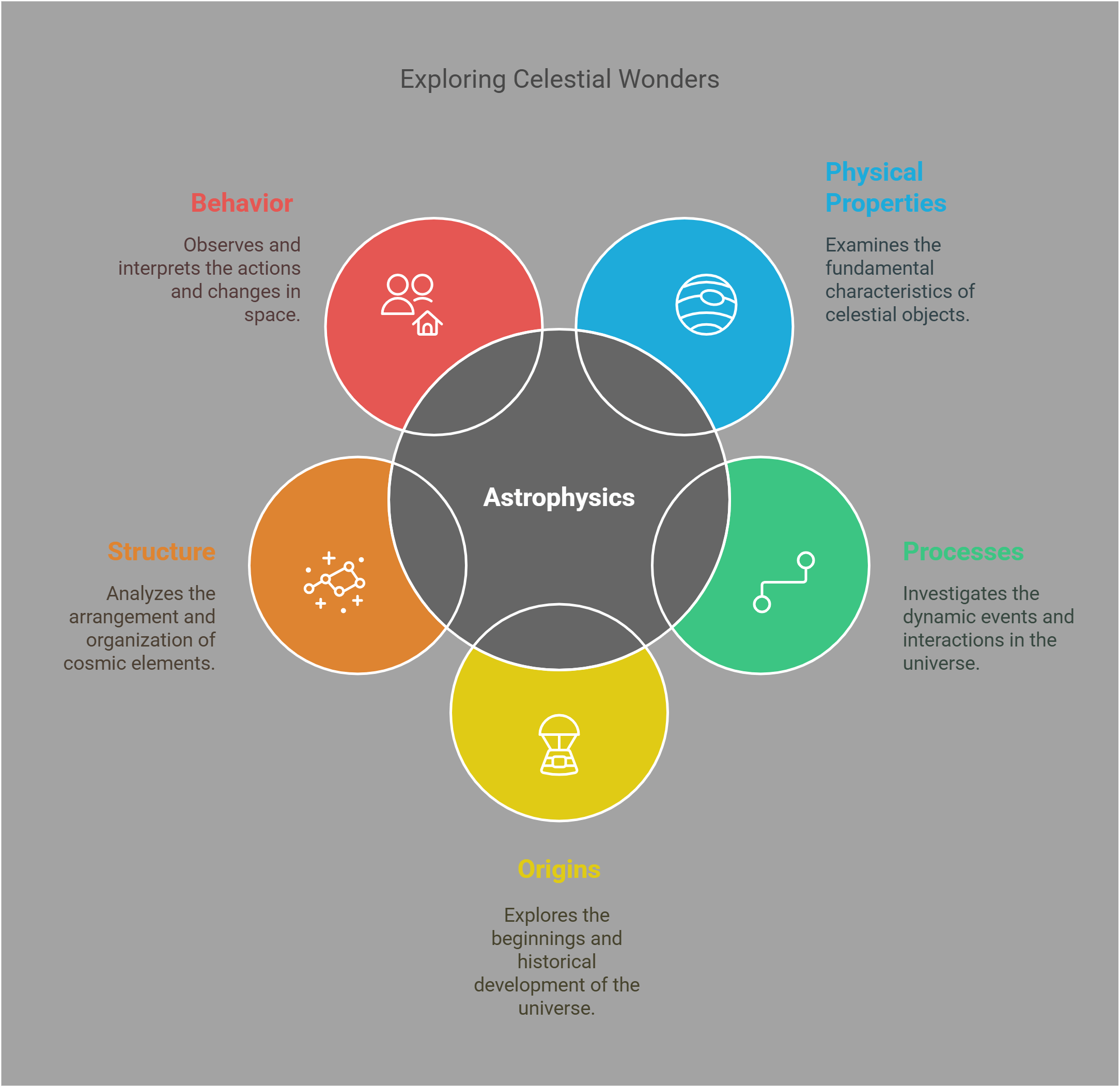
📋 Key Concepts
This guide explores the following essential concepts in astrophysics:
- Black Holes
- Gravitational Waves
- Cosmic Microwave Background
- Exoplanets
- Dark Matter
- Neutron Stars
- Supernovae
- Redshift
- Quasars
- Hubble’s Law

🔍 Detailed Explanations
1. Black Holes
Black holes are regions in space where gravity is so strong that nothing, not even light, can escape. They form when massive stars collapse under their own gravity at the end of their life cycle.
- Key Features:
- Event Horizon: The boundary beyond which nothing can escape.
- Singularity: A point of infinite density at the center of the black hole.
- Accretion Disk: Hot, glowing matter spiraling into the black hole.
- Types of Black Holes:
- Stellar Black Holes: Formed from collapsing stars.
- Supermassive Black Holes: Found at the centers of galaxies, millions to billions of times the Sun’s mass.
- Primordial Black Holes: Hypothetical black holes formed in the early universe.
Example: The supermassive black hole at the center of the Milky Way, Sagittarius A*, was imaged in 2022.
Explained Simply: Black holes are like cosmic whirlpools that trap anything too close, including light.
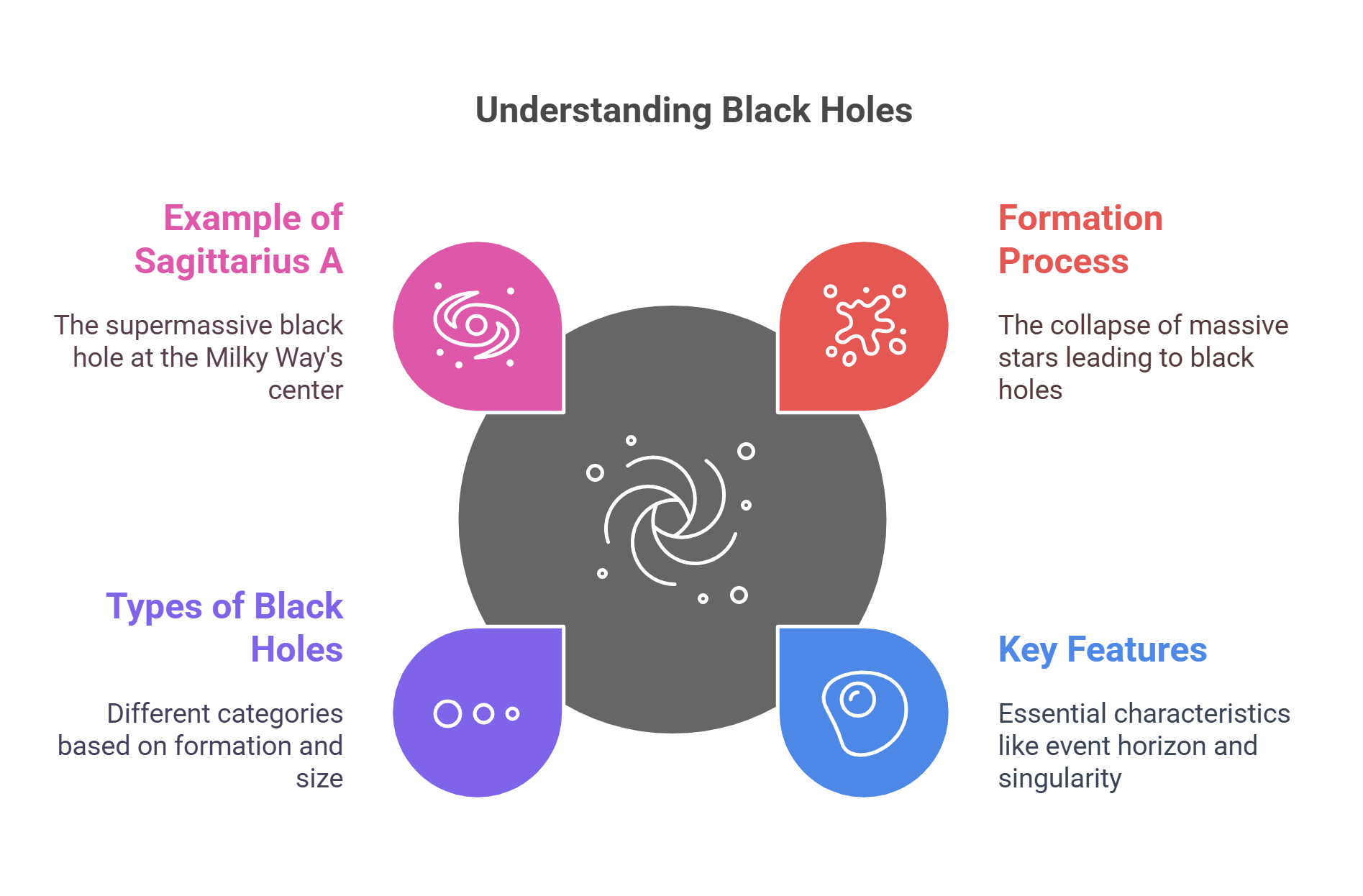
2. Gravitational Waves
Gravitational waves are ripples in spacetime caused by the acceleration of massive objects, as predicted by Einstein’s General Theory of Relativity.
- Sources:
- Merging black holes.
- Colliding neutron stars.
- Exploding supernovae.
- Key Discoveries:
- In 2015, LIGO (Laser Interferometer Gravitational-Wave Observatory) detected gravitational waves for the first time, from merging black holes.
- Applications:
- Provides a new way to observe cosmic events invisible to telescopes.
- Helps confirm the existence of phenomena like binary black hole systems.
Explained Simply: Gravitational waves are like ripples on a cosmic pond, created by massive events in the universe.
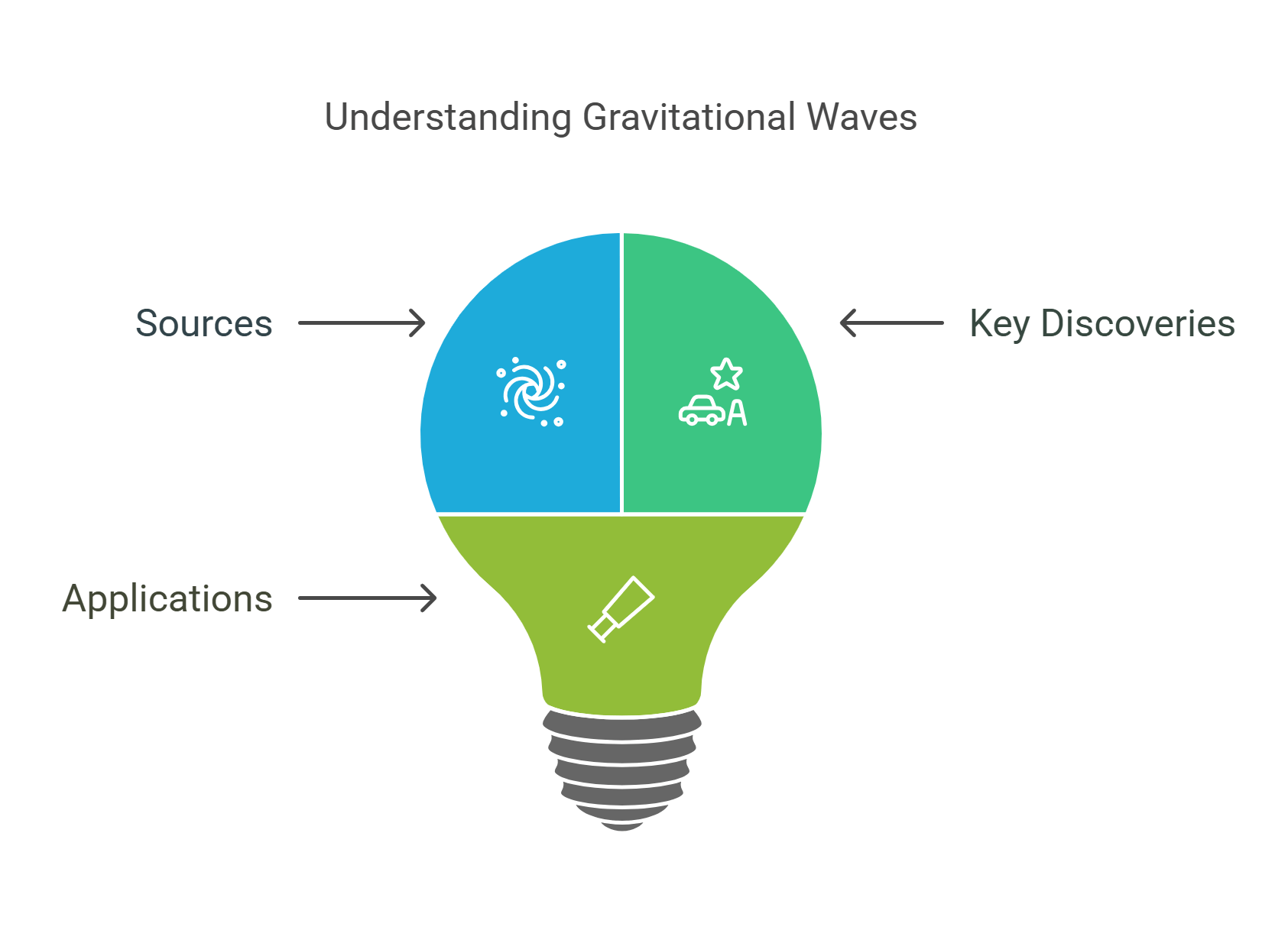
3. Cosmic Microwave Background
The Cosmic Microwave Background (CMB) is the faint afterglow of the Big Bang, providing a snapshot of the universe when it was just 380,000 years old. It is the oldest light in the universe.
- Key Features:
- Uniformity: Nearly the same temperature throughout, with slight fluctuations.
- Temperature: About 2.7 Kelvin, barely above absolute zero.
- Significance:
- Confirms the Big Bang theory.
- The fluctuations in the CMB reveal information about the universe’s early structure and eventual galaxy formation.
Example: NASA’s COBE and WMAP missions mapped the CMB in remarkable detail, providing a blueprint of the early universe.
Explained Simply: The CMB is like a baby picture of the universe, showing what it looked like shortly after birth.
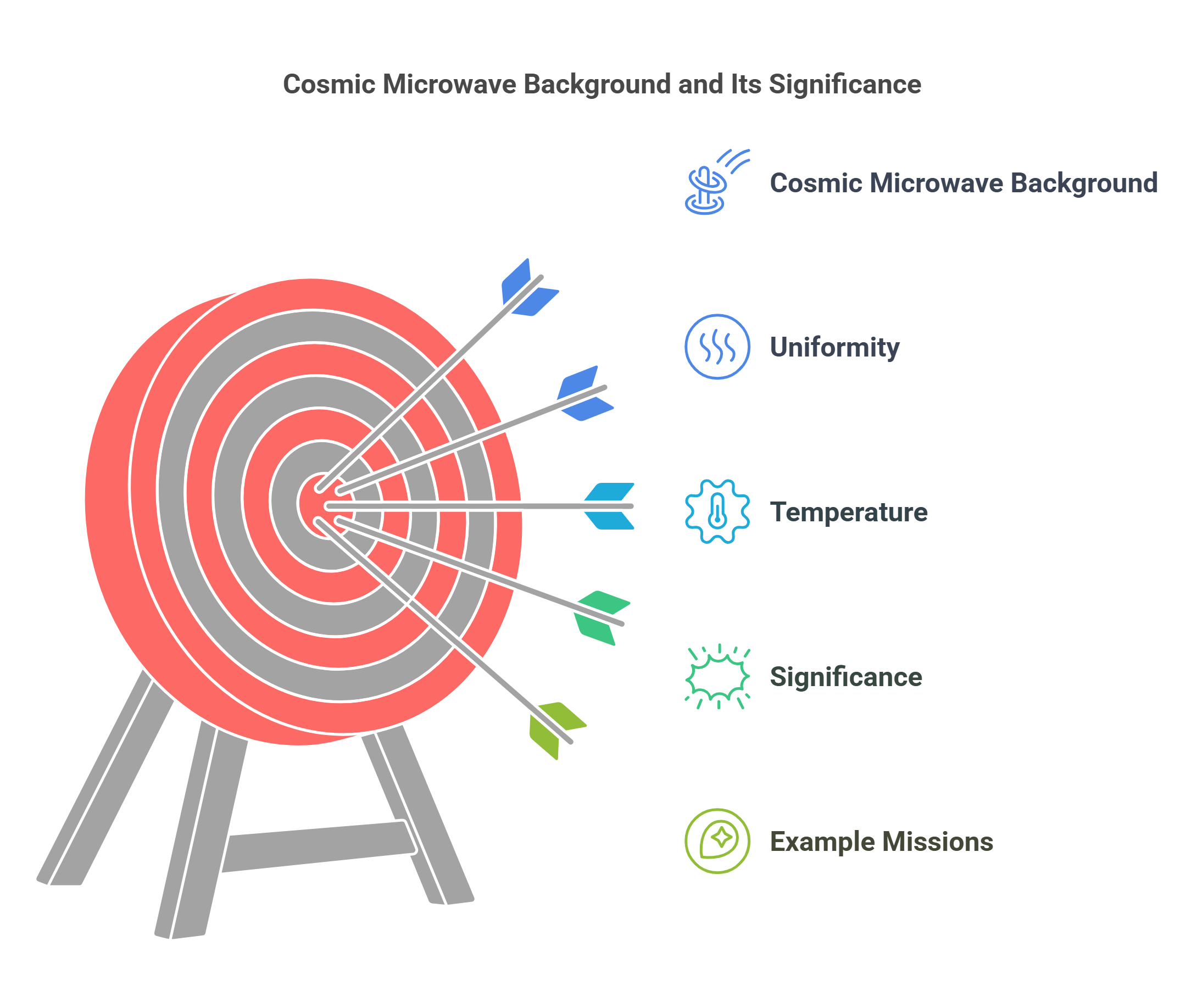
4. Exoplanets
Exoplanets are planets orbiting stars outside our solar system. Their discovery has revolutionized our understanding of planetary systems and the potential for extraterrestrial life.
- Detection Methods:
- Transit Method: Measures dips in a star’s brightness when a planet crosses in front of it.
- Radial Velocity Method: Detects the wobble of a star caused by an orbiting planet’s gravitational pull.
- Key Insights:
- Over 5,000 exoplanets have been confirmed as of 2023, with diverse compositions and orbits.
- Some exoplanets, like those in the “habitable zone,” may have conditions suitable for life.
Example: Proxima Centauri b, an exoplanet orbiting the nearest star to Earth, lies within its star’s habitable zone.
Explained Simply: Exoplanets are like discovering new worlds, each with unique possibilities.
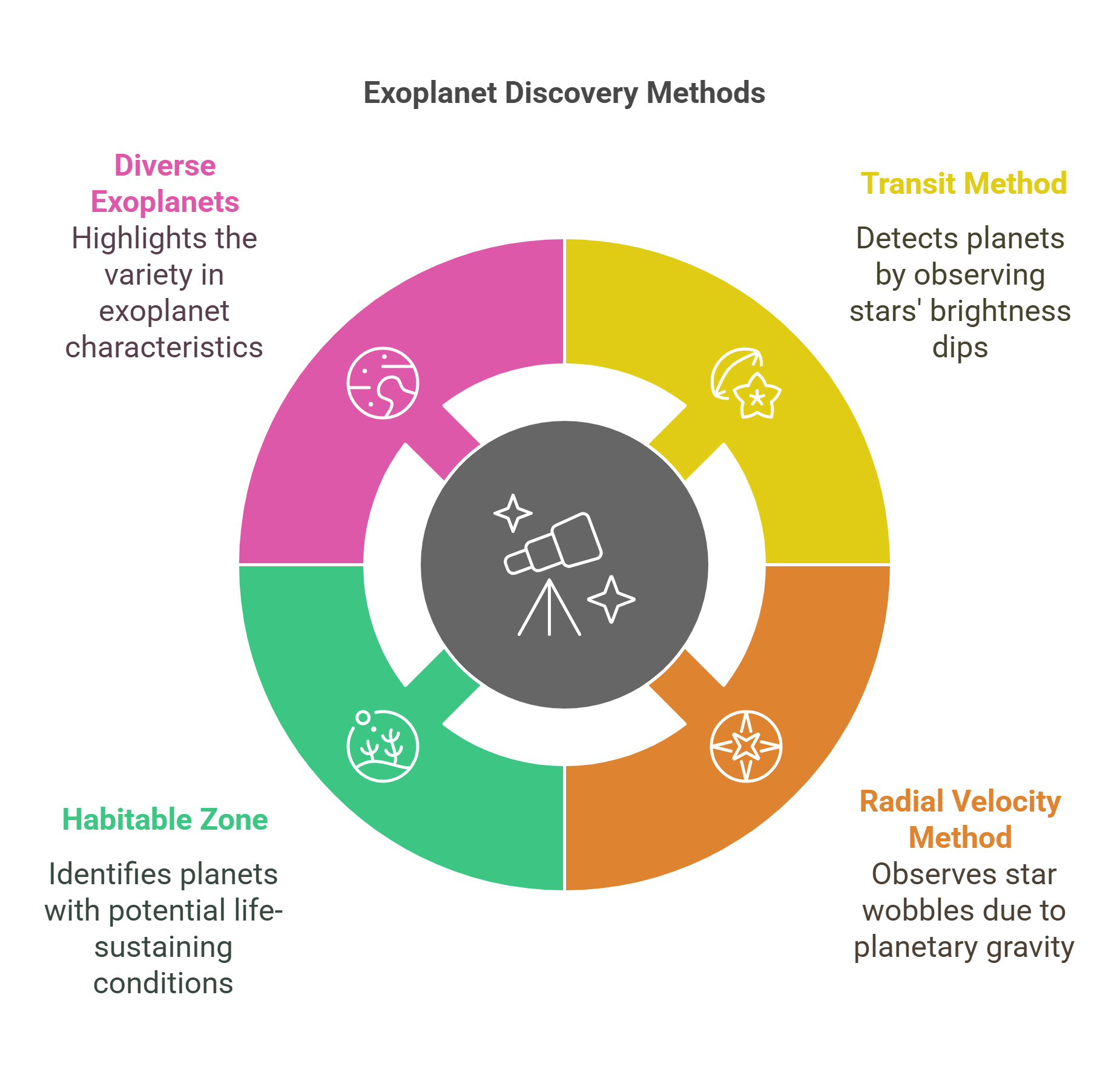
5. Dark Matter
Dark matter is a mysterious form of matter that does not emit, absorb, or reflect light, making it invisible. It constitutes about 27% of the universe’s total mass-energy content.
- Evidence for Dark Matter:
- Galaxy Rotation Curves: Stars in galaxies rotate faster than visible mass can explain.
- Gravitational Lensing: Light from distant objects bends more than expected, suggesting additional unseen mass.
- Key Questions:
- What is dark matter made of? (WIMPs or axions are potential candidates.)
- How does it interact with regular matter?
Explained Simply: Dark matter is like a hidden scaffolding holding galaxies together, though we can’t see or touch it.
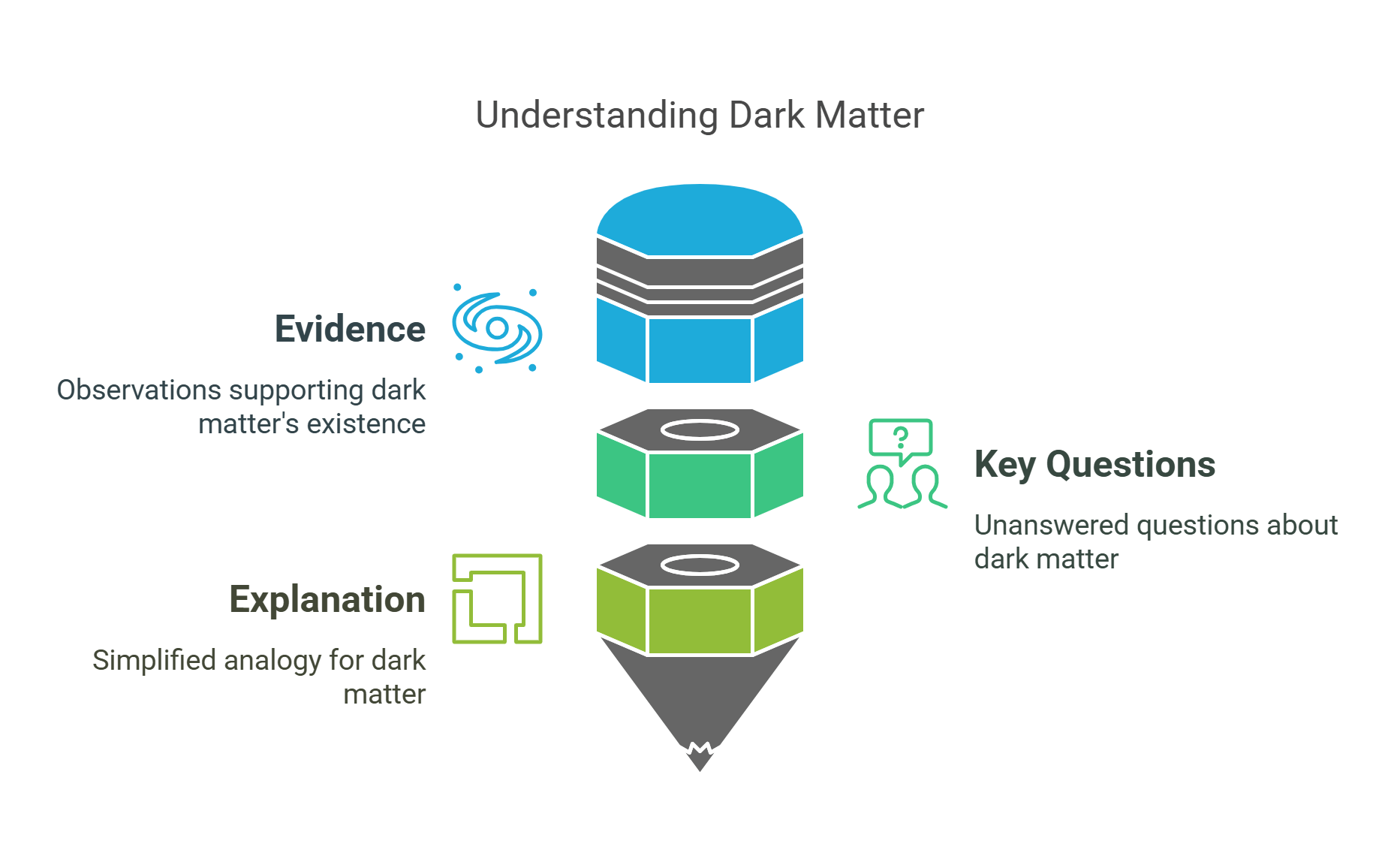
6. Neutron Stars
Neutron stars are the remnants of massive stars that have undergone supernova explosions and collapsed under gravity. They are incredibly dense, composed primarily of neutrons.
- Key Features:
- Density: A sugar-cube-sized amount of neutron star material would weigh billions of tons.
- Magnetic Fields: They possess extremely strong magnetic fields, trillions of times stronger than Earth’s.
- Rotation: Many neutron stars spin rapidly, emitting beams of radiation as pulsars.
- Formation:
- Occurs when a star with a mass between 8–25 times that of the Sun exhausts its nuclear fuel, triggering a supernova.
Example: The Crab Pulsar in the Crab Nebula is a rapidly spinning neutron star formed from a supernova observed in 1054 CE.
Explained Simply: Neutron stars are like cosmic pressure cookers, where gravity crushes atoms into dense neutron-packed spheres.
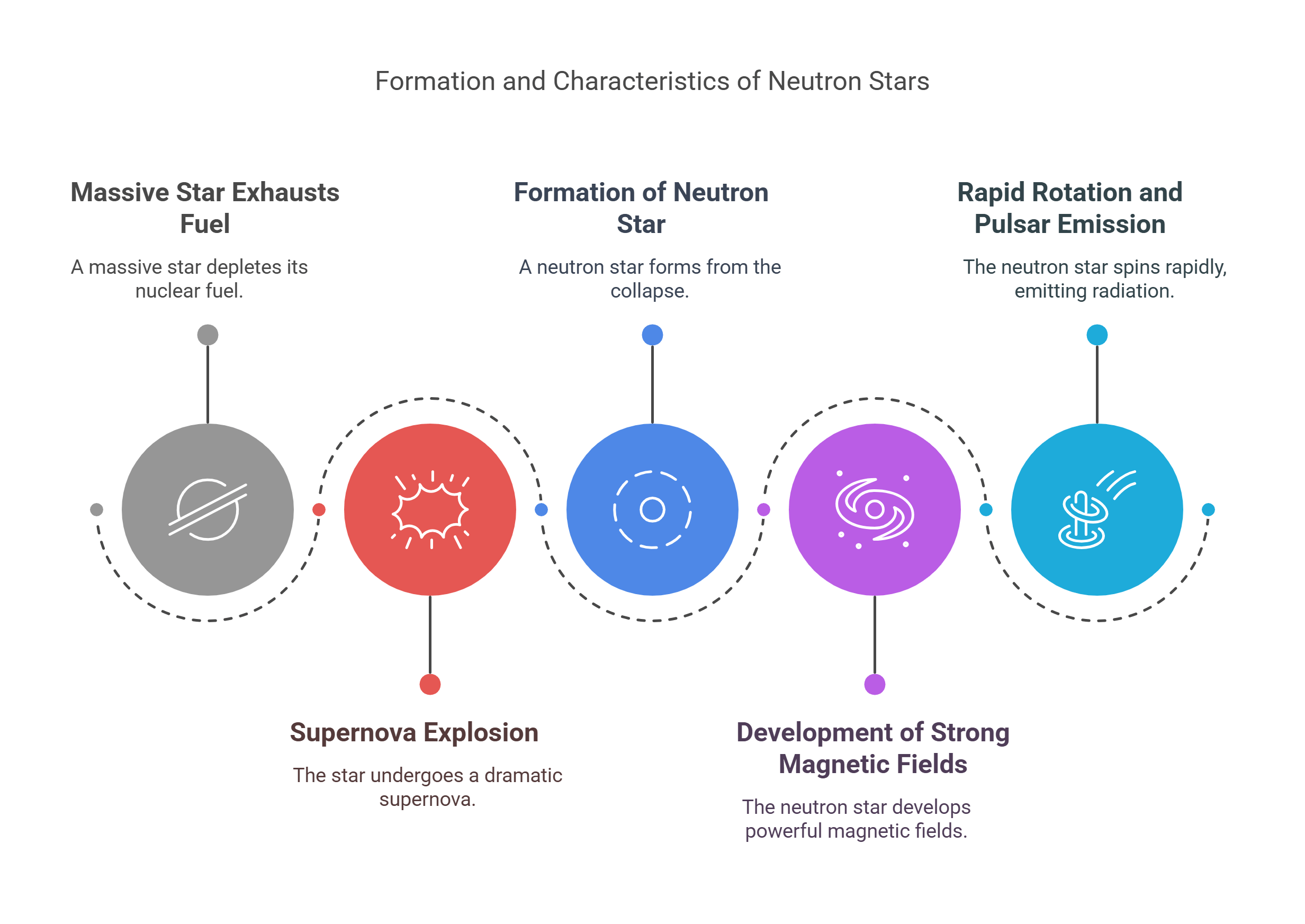
7. Supernovae
A supernova is the explosive death of a star, releasing an enormous amount of energy and creating heavy elements like gold and iron. These events are critical to the cosmic cycle of matter.
- Types of Supernovae:
- Type I: Caused by a white dwarf in a binary system accumulating too much mass from its companion.
- Type II: Result from the collapse of a massive star’s core after nuclear fuel is exhausted.
- Significance:
- Enriches the universe with heavy elements.
- Produces neutron stars or black holes.
- Can trigger the formation of new stars in nearby regions.
Example: The 1987A supernova in the Large Magellanic Cloud provided astronomers with invaluable data on stellar death.
Explained Simply: Supernovae are like cosmic fireworks, marking the end of a star’s life while spreading elements that create new worlds.
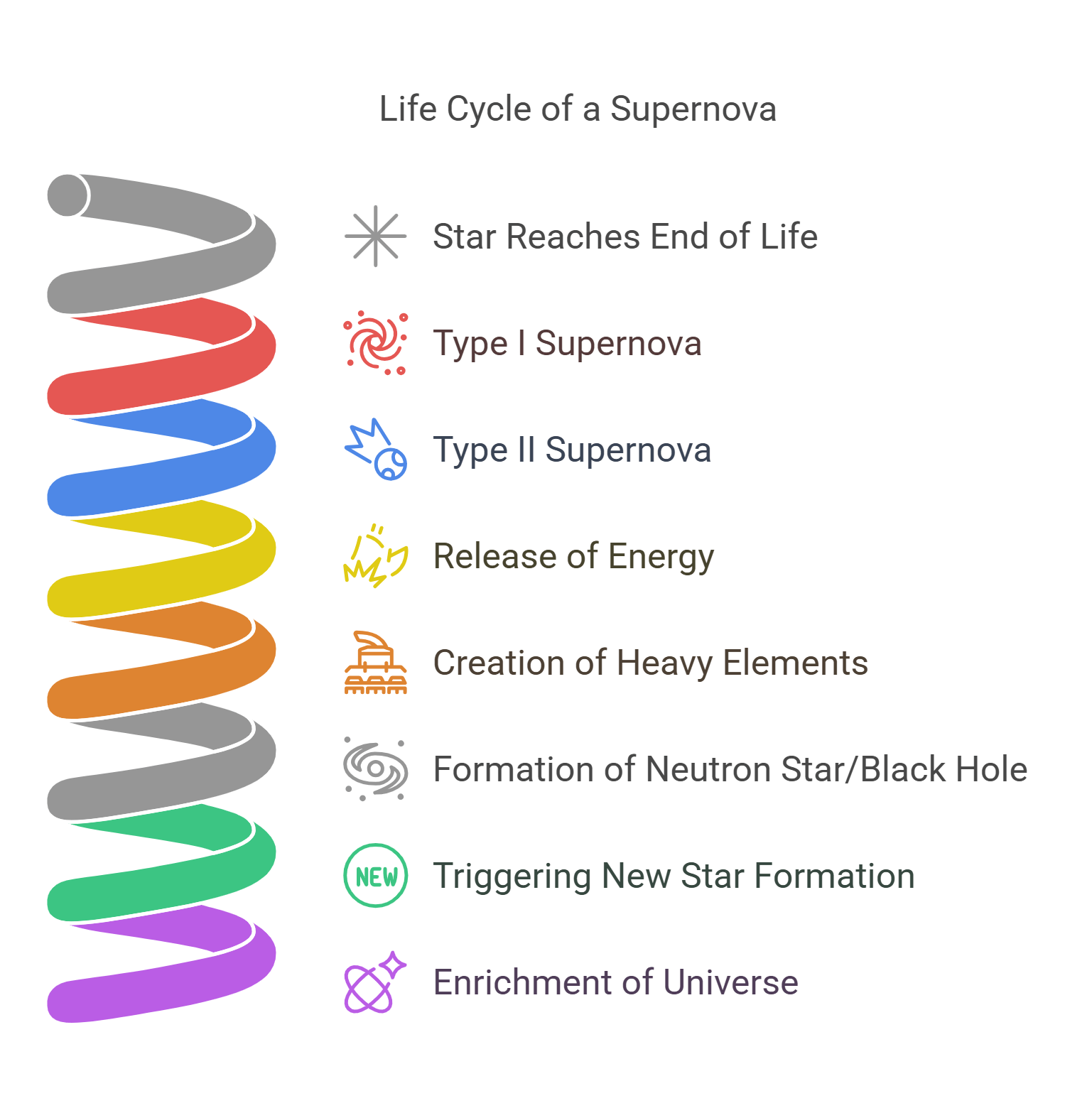
8. Redshift
Redshift refers to the stretching of light to longer (redder) wavelengths as objects in the universe move away from us. It is a key indicator of the universe’s expansion.
- Types of Redshift:
- Doppler Redshift: Caused by the motion of an object moving away from the observer.
- Cosmological Redshift: Due to the stretching of space itself as the universe expands.
- Gravitational Redshift: Light escaping a strong gravitational field loses energy, shifting to red.
- Applications:
- Measures the velocity and distance of galaxies.
- Confirms the Big Bang theory by showing that galaxies are receding from one another.
Example: Edwin Hubble’s observation of redshifted galaxies in the 1920s provided the first evidence for the expanding universe.
Explained Simply: Redshift is like hearing a train’s whistle get lower in pitch as it moves away—except with light, not sound.
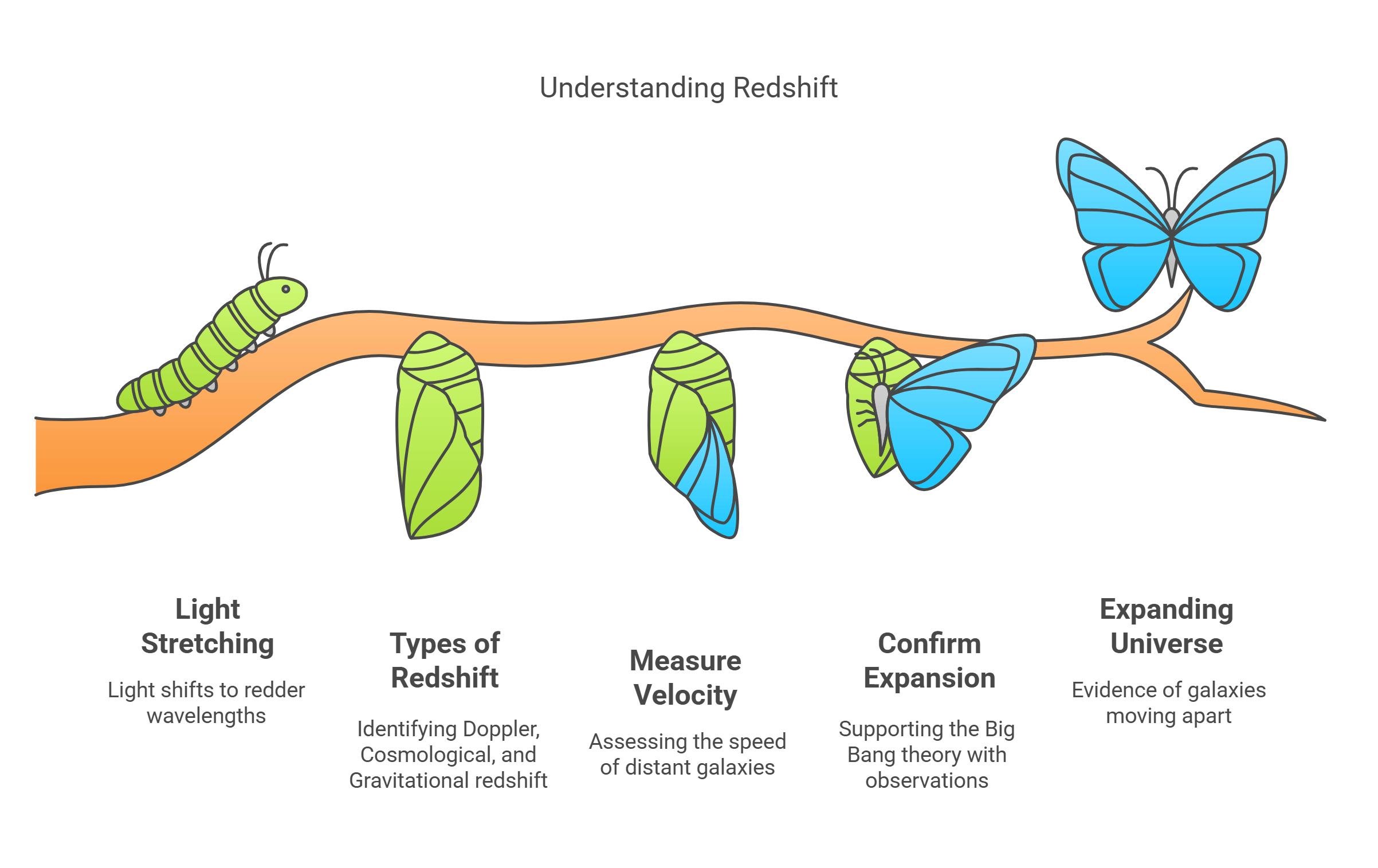
9. Quasars
Quasars (quasi-stellar objects) are extremely luminous and distant celestial objects powered by supermassive black holes at the centers of galaxies. They outshine their host galaxies due to the intense energy released by matter falling into the black hole’s accretion disk.
- Key Features:
- Emit massive amounts of radiation across the electromagnetic spectrum.
- Appear as point-like sources, similar to stars, due to their immense distance.
- Significance:
- Provide insights into the early universe, as many quasars formed when galaxies were young.
- Help map large-scale structures of the universe through their distribution.
Example: Quasar 3C 273, discovered in 1963, is one of the brightest and most studied quasars.
Explained Simply: Quasars are like cosmic lighthouses, powered by voracious black holes in the early universe.
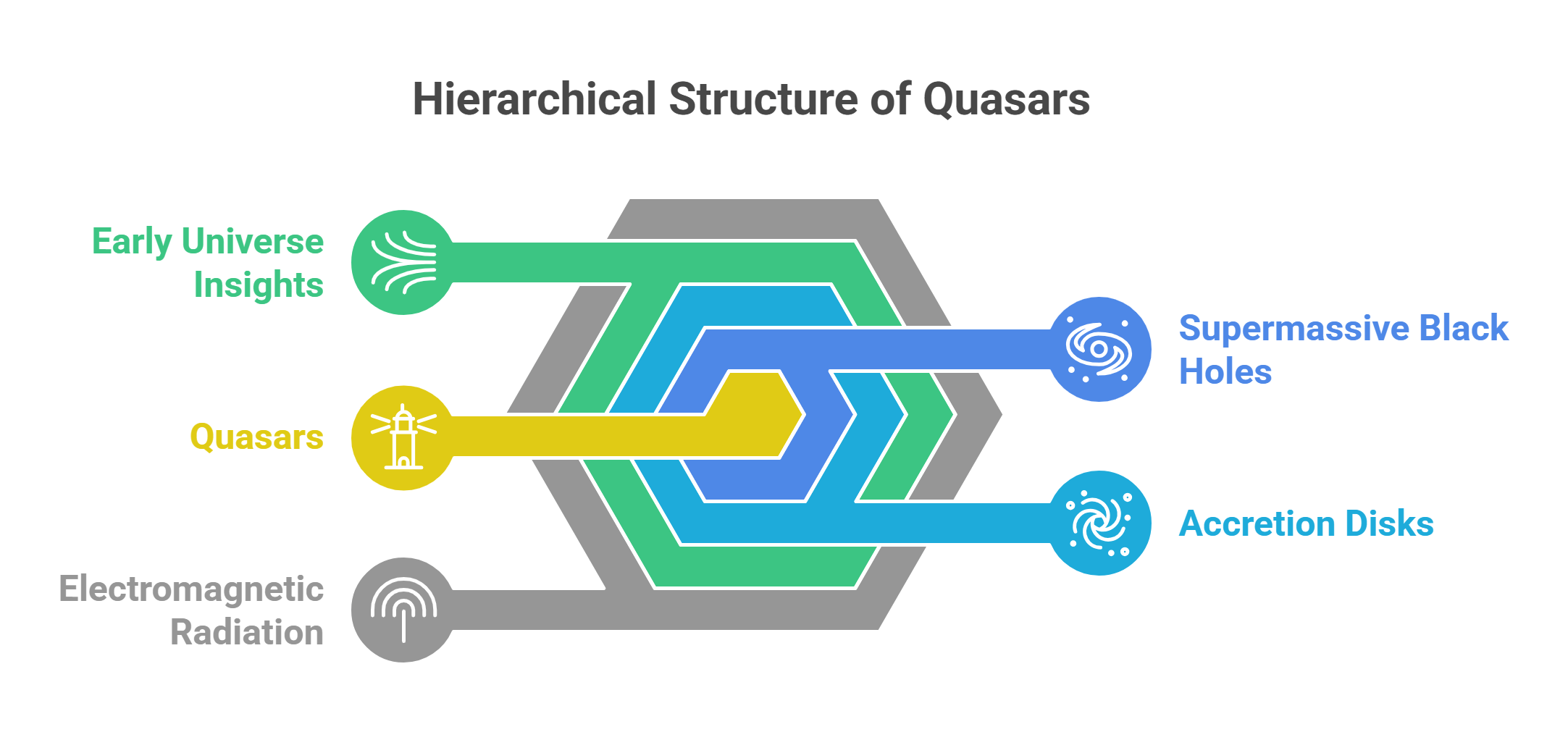
10. Hubble’s Law
Hubble’s Law describes the relationship between the distance of galaxies and their recessional velocity, demonstrating that the universe is expanding.
- Mathematical Expression: v = H0 × d, where v is the galaxy’s velocity, H0 is the Hubble constant, and d is the galaxy’s distance.
- Key Discoveries:
- Distant galaxies move away faster than nearby ones.
- The law provides a way to estimate the age of the universe based on its rate of expansion.
- Significance:
- Confirms the Big Bang theory.
- Helps measure cosmic distances and the scale of the universe.
Example: Observations from the Hubble Space Telescope refined the Hubble constant, deepening our understanding of cosmic expansion.
Explained Simply: Hubble’s Law is like noticing balloons on an inflating balloon moving further apart as the surface stretches.
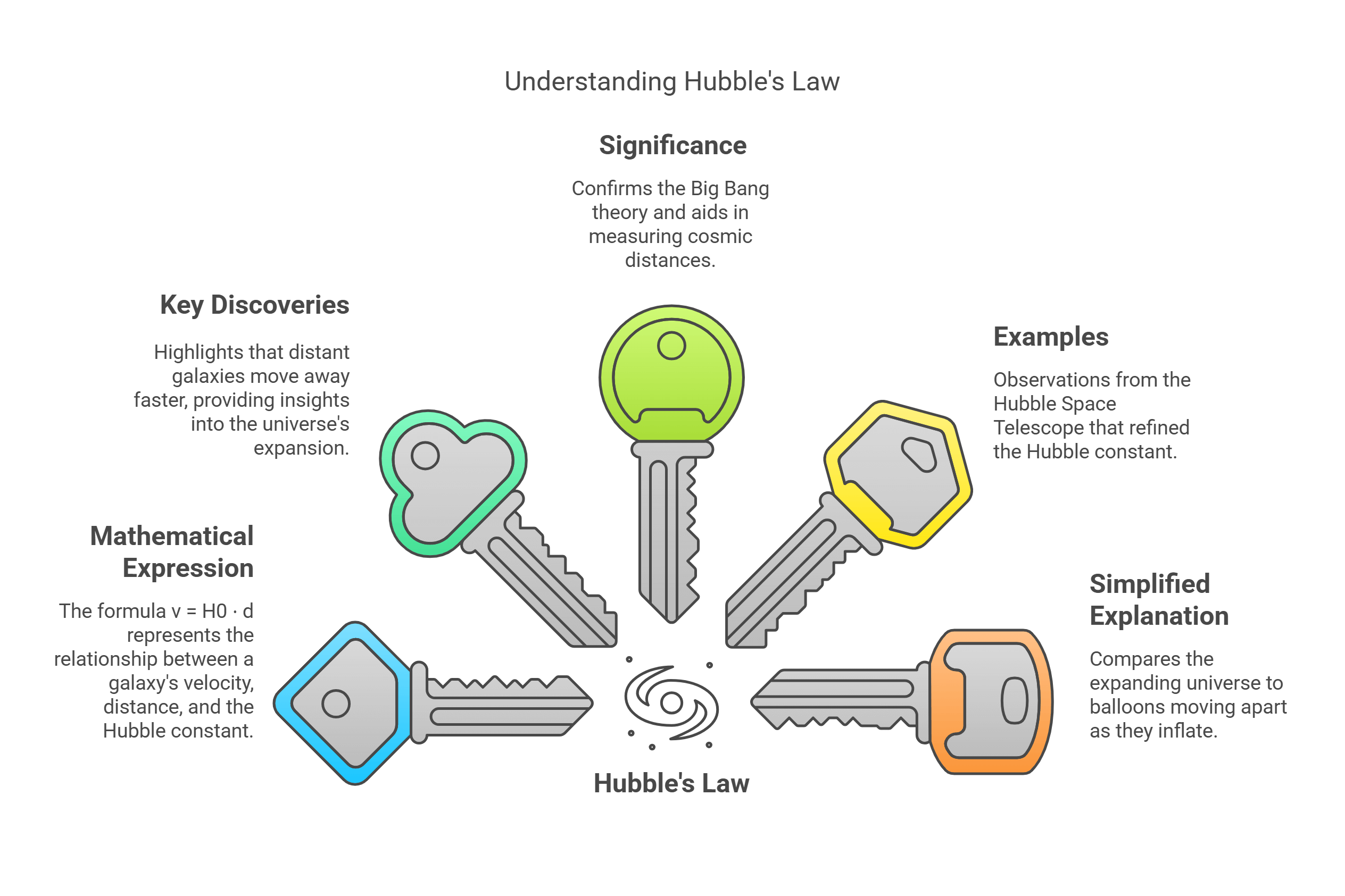
✨ Conclusion
Astrophysics reveals the universe’s vast complexity and beauty, from black holes and neutron stars to the expansion of space itself. By exploring topics like redshift, quasars, and gravitational waves, readers can critically analyze RC passages and appreciate the scientific efforts to uncover the cosmos’s deepest mysteries.










